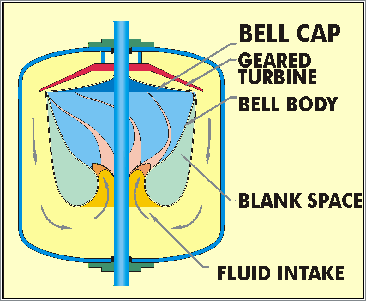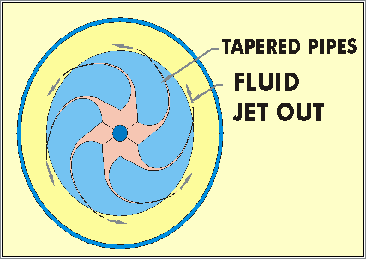


DESIGN ROTOR
The original cone rotor of the engine should be bell shaped and its base blinded off.
SHAFT
Should be solid and retained in bearings on both ends. (Bear with me)
INTAKE SLEEVE
The shaft should have an open concentric sleeve serving as rotor pipe inlet. It should have a diameter ~3x that of the solid shaft at the rotor side and larger diameter open toward suction.
PIPES
The circular (doughnut) cross section of the sleeve inlet should be smoothly transferred into 6 round pipes integral with the rotor. The pipes should spiral in right hand twist toward the base edges of the bell rotor.
The spiraling pipes integral to the rotor should be progressively tapered from the inlet toward the nozzles.
The inlet (larger) diameter of the pipes should be about the same as the diameter of the solid shaft.
The angle of the pipe spiral seems to be reasonable somewhere around 30Deg relative to axis of rotation.
Note that the direction of the twist is independent on which hemisphere you are living in. The twist is related to el.force and current. That is out of the scope of this write up and you would find my explanations really blasphemous.
NOZZLES
Nozzles at the ends of the pipe should be also tapered and oriented tangentially against the direction of the rotation of the rotor. The radius of the "elbow" of the nozzle should be at least two times the mean diameter of the taper on the nozzles. The ends of the nozzles may have to have a vortex breaker within, in order to force a fairly laminar jet of liquid coming out.
TURBINE It may be a good idea to have a turbine driven by the outflow from the nozzles, geared by a planetary gearbox to the rotor shaft.
ORIENTATION
The rotor should be oriented vertically in order to: * Suck liquid from the bottom of the housing in case the housing contains any gas. * Conform to the more natural orientation of flows of turbulence.
FOAMING
Foaming of the liquid has to be solved by either a correct choice of liquid, or by full volume of liquid within the housing without any gas present.
* The drawback of no gas present in the system is a poorer efficiency of reactive force produced at the nozzles.
* Drawbacks of any gas present in the system are described later.
REGULATION
A double shaft hydraulically clutched gearing would allow acceleration of the vehicle as well as braking. A regulated inlet restriction is probably the simplest, but cavitation has to be taken into consideration.
Plugging the intake could be used as emergency safety stop, though.
FILTERING
Any filtering of the liquid is most likely unnecessary due to lack of any active openings in the system small enough to justify it.
If filtering is required, it should be done through external auxiliary system. The main suction of the rotor must not be used for the purpose.

DESIGN PHILOSOPHY
ROTOR
A bell shape should allow the liquid to rapidly accelerate at the begining of the pipe, due to centrifugal force acting at a greater advantage with smaller angle of incline relative to the plane of rotation.
The progressive flattening curve of the bell shape should allow for progressively greater centrifugal pressure against bell wall. This would first of all tend to increase RPM of the rotor and second accelerate the fluid in the pipe further.
The height of the bell should be kept fairly short (approximately the rotor diameter) and should be decided by the tapering curve of the pipes.
SHAFT
The solid shaft should go through the cone and be anchored in bearings at the top and the bottom of the housing for stability.
PIPES
The purpose of the taper is as follows: Whenever a standard piping using pressure is concerned, the back pressure in the wider portion is due to crowding of water molecules being stressed into a smaller diameter.
This means that the tapering is counterproductive to the pressure forced flow.
The molecules of liquid in a suction system tend to move the faster, the closer they are (in our case) to the tip of the nozzles. This means faster and faster traffic of molecules as the liquid approaches the nozzles.
When the pipe is cylindrical, the increase of speed is either prevented all together, or the liquid begins to create vacuum bubbles within, which:
* Is counterproductive to speed increase of the liquid in the pipe. This translates into extra rotational motion of the bell. This is the
main reason why the Clem motor may be self running.
NOZZLES
Should be by now self explaining.
TURBINE
It would have a double purpose.
PRESSURE
As a suction motor, the system depends on sufficient supply of fluid
into the suction port. Then the higher is the pressure within the
system, the higher the RPM possible and the higher the efficiency and
the smaller the engine can be for the purpose. This statement seems
contradictory when looked at from the point of static pressure, but this
is not a static system.
MATH (sort of)
* A linear input of energy causes steady, therefore linear force.
* Linear force causes nonlinear acceleration, therefore nonlinear
increase in velocity.
* Nonlinear increase in velocity causes a nonlinear increase of kinetic
energy of a body, (in our case fluid) therefore, when the exponentially
increased energy of velocity is again used as accelerating force and
that force is again used for acceleration of the same body, it
accelerates further.
IMO, this is catch 22 runaway system. This is why I am convinced that
the Clem engine, as well as some Shauberger's inventions, can become
self running. All it needs is the mechanical translation of acceleration
caused velocity increase into a further accelerating force in a closed
loop, so that the curve of acceleration increase eventually overcomes
the curve of friction increase. When these two curves cross, the system
has to become self accelerating. This is good old Newton.
MANUFACTURING
Will be a bitch. The only people I can think off, who might be able to
make a prototype at a reasonable cost, are the trumpet makers. At least
make the pipes.
AFTERTHOUGHTS
If an evaporative liquid were to be used in a design of partial liquid
volume engine, the engine would start to evaporate the liquid due to
frictional heat up. Then the liquid would vaporise at certain RPM and
the engine would keep running strictly on gaseous atmosphere. This would
alleviate a problem of high RPM start up of gaseous only engine while
giving the advantage of lesser friction and no cavitation.
Looks like I just stated that it will run on gas as well, but will
become self running at substantially higher RPM than liquid one.
All impellers I have ever seen are poorly designed being counter
productive.
email article author Slavek D. Krepelka
* Throw the system into vibrations due to mass imbalances.
This means that the parabolic taper of the pipes is necessary.
The purpose of the spiraling:
* Naturally governed turbulence of liquid in the pipes by the rotation
of the rotor.
* Transfer of centrifugal force into a forward motion of the liquid.
* It would convert lot of remanent energy from the nozzle jets into
aditional torque.
* It would slow down the counter rotating vortex of liquid between the
housing wall and the outside wall of the rotor.
